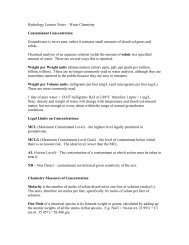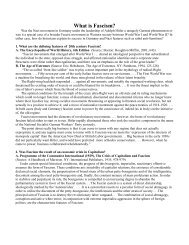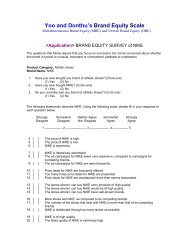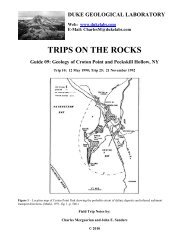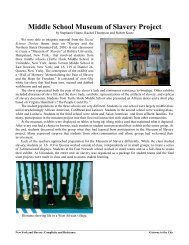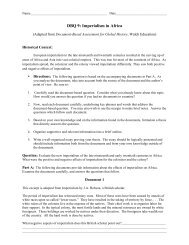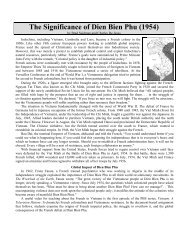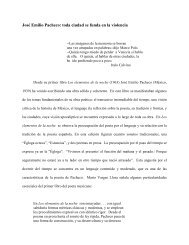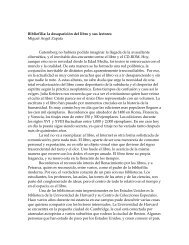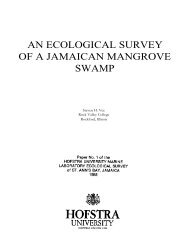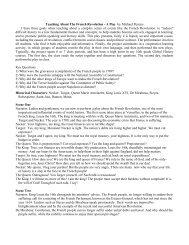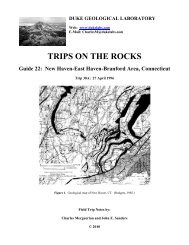Because I have designated this document to be published ... - Hofstra
Because I have designated this document to be published ... - Hofstra
Because I have designated this document to be published ... - Hofstra
You also want an ePaper? Increase the reach of your titles
YUMPU automatically turns print PDFs into web optimized ePapers that Google loves.
OFFICE OF SPECIAL MASTERS<br />
No. 03-550V<br />
(Filed: March 22, 2006)<br />
* * * * * * * * * * * * * * * * * * * * * * * * * * * *<br />
Sierra Howard, by Her Mother and *<br />
Next Friend, CORALEE HOWARD, *<br />
*<br />
Petitioner, * TO BE PUBLISHED1 *<br />
v. *<br />
*<br />
SECRETARY OF HEALTH AND *<br />
HUMAN SERVICES, *<br />
*<br />
Respondent. *<br />
*<br />
* * * * * * * * * * * * * * * * * * * * * * * * * * * *<br />
HASTINGS, Special Master.<br />
DECISION<br />
This is an action in which the petitioner, Coralee Howard, seeks an award under the National<br />
Vaccine Injury Compensation Program (hereinafter “the Program--see 42 U.S.C. § 300aa-10 et<br />
2<br />
seq. ), on account of an injury <strong>to</strong> her daughter, Sierra Howard. For the reasons set forth <strong>be</strong>low, I<br />
conclude that petitioner is not entitled <strong>to</strong> such an award.<br />
1<br />
<strong>Because</strong> I <strong>have</strong> <strong>designated</strong> <strong>this</strong> <strong>document</strong> <strong>to</strong> <strong>be</strong> <strong>published</strong>, <strong>this</strong> <strong>document</strong> will <strong>be</strong> made<br />
available <strong>to</strong> the public unless petitioner files, within fourteen days, an objection <strong>to</strong> the disclosure of<br />
any material in <strong>this</strong> decision that would constitute “medical files and similar files the disclosure of<br />
which would constitute a clearly unwarranted invasion of privacy.” See 42 U.S.C. § 300aa-<br />
12(d)(4)(B): Vaccine Rule 18(b).<br />
2The<br />
applicable statu<strong>to</strong>ry provisions defining the Program are found at 42 U.S.C. § 300aa-10<br />
et seq. (2000 ed.). Hereinafter, for ease of citation, all "§" references will <strong>be</strong> <strong>to</strong> 42 U.S.C. (2000 ed.).<br />
I will also sometimes refer <strong>to</strong> the Act of Congress that created the Program as the “Vaccine Act.”
I<br />
THE APPLICABLE STATUTORY SCHEME<br />
AND CASE LAW<br />
Under the National Vaccine Injury Compensation Program, compensation awards are made<br />
<strong>to</strong> individuals who <strong>have</strong> suffered injuries after receiving vaccines. In general, <strong>to</strong> gain an award, a<br />
petitioner must make a num<strong>be</strong>r of factual demonstrations, including showings that an individual<br />
received a vaccination covered by the statute; received it in the United States; suffered a serious<br />
long-lasting injury; and has received no previous award or settlement on account of the injury.<br />
Finally--and the key question in most cases under the Program--the petitioner must also establish a<br />
causal link <strong>be</strong>tween the vaccination and the injury. In some cases, the petitioner may simply<br />
demonstrate the occurrence of what has <strong>be</strong>en called a "Table Injury." That is, it may <strong>be</strong> shown that<br />
the vaccine recipient suffered an injury of the type enumerated in the “Vaccine Injury Table”<br />
corresponding <strong>to</strong> the vaccination in question, within an applicable time period also specified in the<br />
Table. If so, the Table Injury is presumed <strong>to</strong> <strong>have</strong> <strong>be</strong>en caused by the vaccination, and the petitioner<br />
is au<strong>to</strong>matically entitled <strong>to</strong> compensation, unless it is shown affirmatively that the injury was caused<br />
by some fac<strong>to</strong>r other than the vaccination. § 300aa-13(a)(1)(A); § 300aa-11(c)(1)(C)(I); § 300aa-<br />
14(a); § 300aa-13(a)(1)(B).<br />
In other cases, however, the vaccine recipient may <strong>have</strong> suffered an injury not of the type<br />
covered in the Vaccine Injury Table. In such instances, an alternative means exists <strong>to</strong> demonstrate<br />
entitlement <strong>to</strong> a Program award. That is, the petitioner may gain an award by showing that the<br />
recipient’s injury was “caused-in-fact” by the vaccination in question. § 300aa-13(a)(1)(A); § 300aa-<br />
11(c)(1)(C)(ii). In such a situation, of course, the presumptions available under the Vaccine Injury<br />
Table are inoperative. The burden is on the petitioner <strong>to</strong> introduce evidence demonstrating that, in<br />
fact, the vaccination caused the injury in question. Althen v. Secretary of HHS, 418 F. 3d 1274, 1278<br />
(Fed. Cir. 2005); Hines v. Secretary of HHS, 940 F. 2d 1518, 1525 (Fed. Cir. 1991). The showing<br />
of “causation-in-fact” must satisfy the “preponderance of the evidence” standard, the same standard<br />
ordinarily used in <strong>to</strong>rt litigation. § 300aa-13(a)(1)(A); see also Hines, 940 F. 2d at 1525; Althen, 418<br />
F. 3d at 1278. Under that standard, the petitioner must show that it is “more probable than not” that<br />
the vaccination was the cause of the injury. Althen, 418 F. 3d at 1279. The petitioner need not show<br />
that the vaccination was the sole cause or even the predominant cause of the injury or condition, but<br />
must demonstrate that the vaccination was at least a “substantial fac<strong>to</strong>r” in causing the injury or<br />
condition, and was a “but for” cause. Shyface v. Secretary of HHS, 165 F. 3d 1344, 1352 (Fed. Cir.<br />
1999). Thus, the petitioner must supply “proof of a logical sequence of cause and effect showing<br />
that the vaccination was the reason for the injury;” the logical sequence must <strong>be</strong> supported by<br />
“reputable medical or scientific explanation, i.e., by evidence in the form of scientific studies or<br />
expert medical testimony.” Althen, 418 F. 3d at 1278; Grant v. Secretary of HHS, 956 F. 2d 1144,<br />
1148 (Fed. Cir. 1992).<br />
The Althen court also provided additional discussion of the “causation-in-fact” standard, as<br />
follows:<br />
2
Concisely stated, Althen’s burden is <strong>to</strong> show by preponderant evidence that the<br />
vaccine brought about her injury by providing: (1) a medical theory causally<br />
connecting the vaccination and the injury; (2) a logical sequence of cause and effect<br />
showing that the vaccination was the reason for the injury; and (3) a showing of a<br />
proximate temporal relationship <strong>be</strong>tween vaccination and injury. If Althen satisfies<br />
<strong>this</strong> burden, she is “entitled <strong>to</strong> recover unless the [government] shows also by a<br />
preponderance of evidence, that the injury was in fact caused by fac<strong>to</strong>rs unrelated <strong>to</strong><br />
the vaccine.”<br />
Althen, 418 F. 3d at 1278 (citations omitted). The court noted that a petitioner may not <strong>be</strong> required<br />
<strong>to</strong> supply evidence from medical literature supporting the petitioner’s causation contention, so long<br />
as the petitioner supplies the medical opinion of a qualified expert. The court stressed that a finding<br />
of causation may <strong>be</strong> founded largely upon “circumstantial evidence,” which the court found <strong>to</strong> <strong>be</strong><br />
consistent with the “system created by Congress, in which close calls regarding causation are<br />
resolved in favor of injured claimants.” 418 F. 3d at 1280. 3<br />
In <strong>this</strong> case, the question <strong>to</strong> <strong>be</strong> decided is whether the petitioner has prevailed via the<br />
“causation-in-fact” avenue.<br />
II<br />
FACTS AND PROCEDURAL HISTORY OF THIS CASE<br />
A. Facts appearing in the contemporaneous medical records<br />
Sierra Howard was born on April 8, 1999. During her first year of life she had no significant<br />
health problems, and received a num<strong>be</strong>r of vaccinations, including her first two hepatitis B<br />
vaccinations.<br />
On April 10, 2000, Sierra received her third hepatitis B vaccination, along with a varicella<br />
vaccination (“com vax”) and a hemophilus influenza B (“HIB”) vaccination. (Ex. 4, p. 4. )<br />
4<br />
3<br />
Most recently, the Federal Circuit addressed the causation-in-fact standard once again in<br />
Capizanno v. HHS, No. 05-5049, slip op. (Fed. Cir. March 9, 2006). That opinion cautioned<br />
Program factfinders against <strong>to</strong>o narrowly construing the second element of the Althen test,<br />
confirming that circumstantial evidence and medical opinion, sometimes in the form of notations<br />
of treating physicians in the vaccinee’s medical records, may in a particular case <strong>be</strong> sufficient <strong>to</strong><br />
satisfy that second element of Althen.<br />
4<br />
Petitioner filed Exhibits 1 through 6 on May 28, 2004, and additional, consecutivelynum<strong>be</strong>red<br />
exhibits on numerous occasions thereafter. Respondent has filed Exhibits A and B. “Ex.”<br />
references will <strong>be</strong> <strong>to</strong> those exhibits. “1-Tr.” references will <strong>be</strong> <strong>to</strong> the pages of the transcript of the<br />
evidentiary hearing held on March 15, 2005; “2-Tr.” references will <strong>be</strong> <strong>to</strong> the pages of the transcript<br />
of the hearing held on May 20, 2005.<br />
3
Thereafter, she was not taken <strong>to</strong> see her pediatrician, Dr. Bianchi, or any other physician, until<br />
May 26, 2000. (Ex. 4, pp. 38-39.) At that May 26 visit, Sierra’s mother reported that Sierra had<br />
<strong>be</strong>en experiencing fever, rash, decreased appetite, fussiness, and frequent s<strong>to</strong>ols for “2 days.” (Ex.<br />
4, p. 38.) In the following days, Sierra’s fever and rash worsened, she developed swelling of her<br />
hands and feet, and she was taken for medical attention again at least six times during the next 12<br />
days. (Ex. 28, p. 38; Ex. 4, pp. 34-37; Ex. 5, p. 30.) Two different physicians at that time concluded<br />
that she was suffering from a “viral illness.” (Ex. 4, pp. 34, 36, 37; Ex. 5, p. 30.) In the following<br />
weeks Sierra <strong>be</strong>gan <strong>to</strong> suffer leg problems--ultimately losing the ability <strong>to</strong> stand or walk--abdominal<br />
problems, and other difficulties, and she had a num<strong>be</strong>r of additional physician visits. By August,<br />
Sierra was diagnosed <strong>to</strong> <strong>be</strong> suffering from “eosinophilia” and, ultimately, “hypereosinophilic<br />
5<br />
syndrome,” also known as “HIS.” (Ex. 5, pp. 13, 28.)<br />
Since then, Sierra has continued <strong>to</strong> suffer severe leg problems and other difficulties,<br />
apparently as a result of her HIS. No cause for the HIS has ever <strong>be</strong>en definitively identified.<br />
B. Petitioner’s reports of additional symp<strong>to</strong>ms<br />
In the course of <strong>this</strong> Vaccine Act proceeding, the petitioner, Sierra’s mother, provided<br />
testimony that descri<strong>be</strong>d symp<strong>to</strong>ms which, according <strong>to</strong> petitioner, Sierra displayed during the period<br />
<strong>be</strong>tween April 10 and May 23, 2000. In <strong>this</strong> regard, petitioner provided an affidavit dated July 15,<br />
2004 (Ex. 25), and then oral testimony at the hearing on March 15, 2005. The affidavit and oral<br />
testimony descri<strong>be</strong>d basically the same symp<strong>to</strong>ms, but only the oral testimony descri<strong>be</strong>d when each<br />
symp<strong>to</strong>m <strong>to</strong>ok place during that period.<br />
Petitioner testified that on the evening of the day of Sierra’s vaccinations, April 10, 2000,<br />
Sierra <strong>be</strong>came feverish and also seemed “withdrawn” or “distant.” (1-Tr. 6.) The fever lasted four<br />
or five days, then subsided, but Sierra continued <strong>to</strong> seem “withdrawn” or “depressed” until her next<br />
visit <strong>to</strong> Dr. Bianchi on May 26, 2000. (1-Tr. 7-8.)<br />
Petitioner also testified that about two weeks after the fever subsided (thus, about three weeks<br />
after the April 10 vaccination), Sierra’s feet <strong>be</strong>came “puffy,” meaning slightly enlarged. (1-Tr. 8.)<br />
Sierra’s hands then also <strong>be</strong>came puffy, and thereafter she experienced a slight “splotchy” rash on her<br />
feet, hands, and a bit on her chest. (1-Tr. 8-9, 32.) According <strong>to</strong> petitioner, the puffiness in the<br />
hands and feet, and the rash on the feet, remained until the time of Sierra’s visit <strong>to</strong> Dr. Bianchi on<br />
May 26. (1-Tr. 10, 37.)<br />
5<br />
“Eosinophilia” means that she had an abnormally large num<strong>be</strong>r of eosinophils in her blood;<br />
“hypereosinophilic syndrome” is a condition involving a massive increase in the num<strong>be</strong>r of<br />
th<br />
eosinophils in the blood. Dorland’s Illustrated Medical Dictionary (30 ed. 2003), pp. 624, 881.<br />
Eosinophils are cells that are part of the body’s defense mechanism against invading microganisms.<br />
Eosinophils are normally present in small num<strong>be</strong>rs in the blood. Their inappropriate activation and<br />
increase, however, as in Sierra’s case, can <strong>be</strong> harmful <strong>to</strong> the body. (Charles R. Janeway, et. al.,<br />
th<br />
Immunobiology, § 12-7 (5 ed. 2001).)<br />
4
C. Procedural his<strong>to</strong>ry<br />
The petitioner in <strong>this</strong> case contends that Sierra’s condition of HIS was “caused-in-fact” by<br />
the hepatitis B vaccination that Sierra received on April 10, 2000. The petition was filed on<br />
March 10, 2003, and was assigned on March 20, 2003, <strong>to</strong> Special Master E. LaVon French. On<br />
Decem<strong>be</strong>r 22, 2004, the case was reassigned <strong>to</strong> my docket, due <strong>to</strong> the impending retirement of<br />
Special Master French.<br />
After the case was transferred <strong>to</strong> me, I determined that in order <strong>to</strong> resolve the petitioner’s<br />
“causation-in-fact” contention, it was appropriate that I schedule two separate evidentiary hearings.<br />
First, I would travel <strong>to</strong> petitioner’s home city and hear the testimony of the petitioner, and any other<br />
witnesses that the petitioner desired <strong>to</strong> present, concerning the symp<strong>to</strong>ms that were not mentioned<br />
in the contemporaneous medical records, but were alleged <strong>to</strong> <strong>have</strong> occurred <strong>be</strong>tween April 10 and<br />
May 23, 2000. Then, at a separate hearing I would hear from the parties’ two expert witnesses. In<br />
fact, two such hearings were held, on March 15, 2005, and May 20, 2005, respectively.<br />
After the second hearing, at the request of petitioner’s counsel, the parties agreed <strong>to</strong> file posthearing<br />
briefs. Each party filed briefs on August 26 and Septem<strong>be</strong>r 16, 2005.<br />
III<br />
SUMMARY OF EXPERTS’ OPINIONS<br />
As noted above, both parties in <strong>this</strong> case <strong>have</strong> presented the opinions of medical experts. I<br />
will now summarize the opinions of each of the two experts.<br />
A. Summary of Dr. Katz’ opinion<br />
Petitioner’s expert, Dr. Roger Katz, submitted a written expert report (Ex. 26), and later<br />
testified at the second evidentiary hearing on May 20, 2005. Dr. Katz is a physician who is boardcertified<br />
in immunology, pediatrics, and the treatment of allergies and pediatric allergies. His<br />
testimony concerning the causation issue may <strong>be</strong> summarized as follows.<br />
Dr. Katz opined that the hepatitis B vaccination that Sierra received on April 10, 2000,<br />
6<br />
caused her HIS. In forming his opinion, Dr. Katz relied upon the his<strong>to</strong>ry of symp<strong>to</strong>ms provided by<br />
Sierra’s mother in <strong>this</strong> proceeding. That is, while neither his report nor his hearing testimony was<br />
very clear or precise in <strong>this</strong> regard, he seems <strong>to</strong> <strong>have</strong> assumed that Sierra experienced a fever within<br />
24 hours after vaccination; that her fever lasted several days; that about two weeks later she<br />
6<br />
At the evidentiary hearing, Dr. Katz pointed only <strong>to</strong> the hepatitis B vaccination, which Sierra<br />
received on April 10, 2000, as the cause of her HIS. (2-Tr. 20-21.) Earlier, in his written report,<br />
however, Dr. Katz had opined that it could <strong>have</strong> <strong>be</strong>en either the hepatitis B vaccination or the<br />
varicella vaccination that she also received on the same day. (Ex. 26, p. 2.)<br />
5
experienced puffiness of the hands and feet as well as a rash; and that she was “not responding well”<br />
(2-Tr. 23) <strong>to</strong> her parents and was “not her usual self” (2-Tr. 25) during the period <strong>be</strong>tween April 10<br />
and May 26. (Ex. 26, p. 1; 2-Tr. 12-13, 23-29.)<br />
Dr. Katz pointed <strong>to</strong> two articles in the medical literature which, he opined, indicate that the<br />
hepatitis B vaccine can cause HIS. (2-Tr. 19.) He opined that the hepatitis B vaccine stimulated<br />
Sierra’s immune system, provoking an “au<strong>to</strong>immune response,” i.e., a response in which the body’s<br />
immune system inappropriately attacks parts of the body itself, rather than attacking some invading<br />
agent as the immune system is designed <strong>to</strong> do. (2-Tr. 16-21.)<br />
Dr. Katz opined that the symp<strong>to</strong>ms that Sierra’s mother descri<strong>be</strong>d as occurring in the first few<br />
weeks after her hepatitis B vaccination of April 10, 2000--i.e., the fever, rash, and puffiness of hands<br />
and feet--were the first symp<strong>to</strong>ms of Sierra’s HIS. He concluded that <strong>this</strong> timing of the symp<strong>to</strong>ms<br />
supports the proposition that the vaccine caused the symp<strong>to</strong>ms. In <strong>this</strong> regard, he noted the fact that<br />
<strong>this</strong> was Sierra’s third hepatitis B vaccination, so her immune system would react immediately <strong>to</strong><br />
7<br />
the vaccine. (E.g., 2-Tr. 12-13, 21.)<br />
Dr. Katz also noted, in support of his theory, that other likely causes for HIS had <strong>be</strong>en<br />
investigated and ruled out in Sierra’s case. (Ex. 26, pp. 1, 2.)<br />
B. Summary of Dr. Berger’s opinion<br />
Respondent’s expert, Dr. Melvin Berger, also submitted an expert report (Ex. A, first filed<br />
on Decem<strong>be</strong>r 22, 2004, and then refiled in corrected form on January 7, 2005), and also testified at<br />
the evidentiary hearing on May 20, 2005. Dr. Berger is a physician who is board-certified in<br />
pediatrics, allergy, and immunology. Dr. Berger opined that the available evidence does not justify<br />
a conclusion that the hepatitis B vaccination caused Sierra’s HIS. Rather, Dr. Berger <strong>be</strong>lieves that<br />
Sierra’s HIS was caused by a viral infection, the first symp<strong>to</strong>ms of which occurred on or about<br />
May 24, 2000.<br />
Dr. Berger relies on the fact that the medical records made in 2000 indicate the abrupt onset<br />
of an acute illness in Sierra on or about May 24, 2000. Those records indicate a progression of<br />
Sierra’s symp<strong>to</strong>ms from that time until her diagnosis of HIS. In Dr. Berger’s view, that acute illness<br />
which <strong>be</strong>gan about May 24, likely a viral infection, resulted in Sierra’s HIS.<br />
Dr. Berger testified that he did not disregard the testimony of petitioner describing certain<br />
symp<strong>to</strong>ms in Sierra <strong>be</strong>tween April 10 and May 23 of 2000. He opined, however, that any symp<strong>to</strong>ms<br />
7<br />
At the hearing, Dr. Katz referred <strong>to</strong> <strong>this</strong> type of immediate response <strong>to</strong> a repeat vaccination<br />
as an “amnestic” response, and, upon inquiry, spelled the word that way. (2-Tr. 21.) Reference <strong>to</strong><br />
a medical dictionary, however, indicates that the word that Dr. Katz apparently had in mind was<br />
th<br />
“anamnestic.” See Dorland’s Illustrated Medical Dictionary (W.D. Saunders Co., 27 ed. 1988),<br />
p. 72.<br />
6
occurring during that period were likely not of much significance, since Sierra’s family never <strong>to</strong>ok<br />
her <strong>to</strong> see a physician during that time period. Dr. Berger also explained that he could not<br />
understand how the hepatitis B vaccination of April 10 could produce only very mild symp<strong>to</strong>ms<br />
during the first several weeks after vaccination, and then suddenly produce an abrupt, acute<br />
activation of Sierra’s immune system more than six weeks later, about May 24.<br />
IV<br />
PRIMARY ANALYSIS<br />
Based upon all the evidence of record in <strong>this</strong> case, I conclude that petitioner has failed <strong>to</strong><br />
demonstrate that it is “more probable than not” that Sierra’s HIS was caused by her hepatitis B<br />
vaccination of April 10, 2000. My reasons for <strong>this</strong> conclusion can <strong>be</strong> divided in<strong>to</strong> two different<br />
primary lines of analysis. First, I find it unlikely that Sierra in fact experienced the alleged<br />
symp<strong>to</strong>ms, during the period <strong>be</strong>tween April 10 and May 23, 2000, upon which Dr. Katz based his<br />
opinion. Second, even if I were <strong>to</strong> assume the accuracy of the petitioner’s testimony concerning the<br />
alleged symp<strong>to</strong>ms <strong>be</strong>tween April 10 and May 23, 2000, I would still find the analysis of Dr. Berger<br />
<strong>to</strong> <strong>be</strong> more persuasive than that of Dr. Katz.<br />
A. The symp<strong>to</strong>m his<strong>to</strong>ry relied upon by Dr. Katz<br />
After fully considering the testimony of Sierra’s mother, the petitioner, and comparing that<br />
testimony <strong>to</strong> the evidence contained in the medical records, I find it unlikely that Sierra in fact<br />
experienced the set of symp<strong>to</strong>ms, during the period <strong>be</strong>tween April 10 and May 23, 2000, upon which<br />
Dr. Katz relied. The chief reason is that none of the many medical records made during the year<br />
2000--or any medical records made within two years of the time period in question--make any<br />
mention of those alleged symp<strong>to</strong>ms.<br />
1. The contemporaneous records do not mention any symp<strong>to</strong>ms prior <strong>to</strong> May 24<br />
When Sierra was taken <strong>to</strong> see Dr. Bianchi on May 26, 2000, the notes of that visit indicate<br />
that Sierra had <strong>be</strong>en experiencing a rash and fever for two days, and also that she had a decreased<br />
appetite, frequent s<strong>to</strong>ols, and was “fussy,” with no vomiting. (Ex. 4, p. 38.) No mention was made<br />
of any symp<strong>to</strong>ms over the previous six weeks, from April 10 through May 23. Over the next 12 days<br />
after that May 26 visit, Sierra was taken <strong>to</strong> see physicians at least six more times, and again no<br />
notation was ever made in the medical records of any symp<strong>to</strong>ms during the period from April 10<br />
<strong>to</strong> May 23. (Ex. 25, p. 38; Ex. 4, pp. 34-37; Ex. 5, p. 30.) More visits occurred over the following<br />
weeks, and again no mention was made of any symp<strong>to</strong>ms occurring prior <strong>to</strong> the rash and fever that<br />
<strong>be</strong>gan about May 24.<br />
For example, when Sierra was first admitted <strong>to</strong> a hospital, at the Tucson Medical Center on<br />
August 17, 2000, Dr. Bianchi recorded a his<strong>to</strong>ry of her illness, <strong>be</strong>ginning with “I first saw her on<br />
May 26 with a complaint of rash and fever.” (Ex. 11, p. 48.) No mention was made of any<br />
7
symp<strong>to</strong>ms occurring prior <strong>to</strong> the report on May 26 of a two-day his<strong>to</strong>ry of rash and fever. Thus,<br />
when Dr. Bianchi admitted Sierra <strong>to</strong> the hospital on August 17, 2000, he seems <strong>to</strong> <strong>have</strong> concluded<br />
that the onset of her illness was the two-day his<strong>to</strong>ry of rash and fever reported on May 26.<br />
Next, when Sierra was transferred from the Tucson Medical Center <strong>to</strong> the University Medical<br />
Center on August 22, 2000, two his<strong>to</strong>ries of Sierra’s illness were recorded on the same page, in two<br />
8<br />
different handwritings. (Ex. 5, p. 54.) In the notes on the left side of the page, the his<strong>to</strong>ry <strong>be</strong>gins<br />
with “3 mth PTA [3 months prior <strong>to</strong> admission] fever, rash.” (Id.) This record, thus, again seems<br />
<strong>to</strong> indicate that the rash and fever reported <strong>to</strong> <strong>have</strong> <strong>be</strong>gun about May 24, 2000--almost exactly 3<br />
months prior <strong>to</strong> the 8-22-00 admission--were the first symp<strong>to</strong>ms of Sierra’s illness. Similarly, the<br />
notes in a different handwriting, on the right side of the page, list, as the earliest symp<strong>to</strong>m of Sierra’s<br />
illness, a “purple-red rash” occurring “3 mo. ago,” which was treated by “steroids [for] 15 days.”<br />
(Id.) This his<strong>to</strong>ry, <strong>to</strong>o, seems also clearly <strong>to</strong> descri<strong>be</strong> the rash that appeared about May 24, 2000,<br />
9<br />
which was in fact treated by steriods, as the first symp<strong>to</strong>m of Sierra’s overall illness. In addition,<br />
when Sierra first visited the rheuma<strong>to</strong>logist, Dr. Hollister, on Septem<strong>be</strong>r 25, 2000, he wrote that<br />
Sierra “first <strong>be</strong>came ill approximately four months ago with fever and rash,” prompting treatment<br />
by steroids. (Ex. 7, p. 16.) Thus, not only is the notation of “four months ago” consistent with onset<br />
at around May 24, but Dr. Hollister, again, descri<strong>be</strong>s the onset of the disease as <strong>be</strong>ginning with a<br />
fever and rash, prompting steroid treatment. Again, <strong>this</strong> description seems clearly <strong>to</strong> descri<strong>be</strong> the<br />
abrupt onset of fever and rash on May 24, first reported <strong>to</strong> Dr. Bianchi on May 26.<br />
In short, the medical records made in the year 2000 make no mention at all of the symp<strong>to</strong>ms<br />
now descri<strong>be</strong>d by petitioner, making it seem doubtful that such symp<strong>to</strong>ms occurred. 10<br />
8<br />
At the bot<strong>to</strong>m of pages 54 and 55 of Exhibit 5 appears the name of a resident physician,<br />
Dr. Colleen K. Cagno. It would seem likely, then, that Dr. Cagno wrote one of the two his<strong>to</strong>ries on<br />
p. 54, and that the other was recorded by someone else.<br />
9<br />
Interestingly, <strong>this</strong> his<strong>to</strong>ry, on the right hand side of the page, notes that “3 ½ months ago”<br />
Sierra’s grandmother “returned from China,” but, conspicuously, fails <strong>to</strong> note any symp<strong>to</strong>ms in Sierra<br />
until “3 mo. ago.” (Ex. 5, p. 54.)<br />
10<br />
Numerous Program decisions <strong>have</strong> noted the general principle that contemporaneouslyrecorded<br />
records should ordinarily <strong>be</strong> given greater evidentiary weight than witness recollections<br />
offered long after the event in question. See Cucuras v. Secretary of HHS, 26 Cl. Ct. 537, 542<br />
(1992), aff’d, 993 F. 2d 1525, 1528 (Fed. Cir. 1993); Beddingfield v. Secretary of HHS, 50 Fed. Cl.<br />
520, 523-524 (2001); Estate of Arrowood v. Secretary of HHS, 28 Fed. Cl. 453, 458 (1993); Reusser<br />
v. Secretary of HHS, 28 Fed. Cl. 516, 523 (1993); Murphy v. Secretary of HHS, 23 Cl. Ct. 726, 733<br />
(1991), aff’d, 968 F. 2d 1226 (Fed. Cir. 1992), cert. denied, 506 U.S. 974 (1992). See also the same<br />
principle noted in non-Program decisions such as United States v. United States Gypsum Co., 333<br />
U.S. 364, 396 (1947); Montgomery Coca Cola Bottling Co. v. United States, 222 Ct. Cl. 356, 615<br />
F. 2d 1318, 1328 (Ct. Cl. 1980).<br />
8
2. The records which estimate a certain num<strong>be</strong>r of months of illness<br />
Next, I note that there were several his<strong>to</strong>ries recorded in August or Septem<strong>be</strong>r of 2000 that<br />
simply list Sierra as having <strong>be</strong>en sick for a certain num<strong>be</strong>r of months, without giving any additional<br />
detail. These his<strong>to</strong>ries are not of crucial evidentiary weight, since they are so nonspecific. That is,<br />
if a person estimates that something <strong>be</strong>gan “about three months ago,” that estimate usually does not<br />
mean precisely three months ago. It is an estimate; the person is not usually attempting <strong>to</strong> <strong>be</strong><br />
specific. It could mean 2 ½ months ago or 3 ½ months ago, or even two months or four months ago.<br />
So, such his<strong>to</strong>ries obviously <strong>have</strong> limited evidentiary value for purposes of pinpointing the precise<br />
onset of an occurrence. Nevertheless, the his<strong>to</strong>ries of <strong>this</strong> type contained in the record here are still<br />
worth a brief mention.<br />
Several his<strong>to</strong>ries recorded in late August state that Sierra <strong>be</strong>came sick about three months<br />
prior. I <strong>have</strong> already mentioned above the two different his<strong>to</strong>ries recorded at the hospital on<br />
August 22, at Ex. 5, p. 54, both indicating onset three months <strong>be</strong>forehand. There is another report<br />
of a “three month” his<strong>to</strong>ry, also apparently made on August 22, at Ex. 5, p. 57. Other reports of<br />
“three-month” his<strong>to</strong>ries were recorded on August 24 (Ex. 5, p. 81); August 25 (Ex. 5, p. 85); and<br />
Septem<strong>be</strong>r 1 (Ex. 5, p. 138). Similarly, in the discharge summary from Sierra’s hospitalization that<br />
<strong>be</strong>gan on August 22, it is stated that she was “admitted after a three-month his<strong>to</strong>ry” of illness.<br />
(Ex. 5, p. 43.) All these his<strong>to</strong>ries, describing during late August (or on Septem<strong>be</strong>r 1) a “three month”<br />
his<strong>to</strong>ry, would <strong>be</strong> consistent with onset about May 24, as indicated by Dr. Bianchi’s first his<strong>to</strong>ry<br />
taken on May 26. In addition, as also mentioned above, when Sierra first visited Dr. Hollister on<br />
Septem<strong>be</strong>r 25, 2000, he recorded the illness as <strong>be</strong>ginning “four months ago,” again consistent with<br />
onset about May 24. (Ex. 7, p. 16.) 11<br />
On the other hand, three of the general his<strong>to</strong>ries recorded in August diverge somewhat from<br />
the his<strong>to</strong>ries descri<strong>be</strong>d above. First, on August 8, 2000, Sierra visited Dr. Shehab, a pediatric<br />
infectious disease specialist. In the notes of that visit, it was recorded that Sierra was “still sick--now<br />
almost three months” (Ex. 5, p. 11), which prompted Dr. Shehab <strong>to</strong> write that Sierra had <strong>be</strong>en sick<br />
“over the past three months” (Ex. 5, p. 8). Of course, onset exactly three months earlier than<br />
August 8 would place the onset somewhat earlier than the May 24 date indicated by the record of<br />
Dr. Bianchi on May 26. However, at <strong>this</strong> August 8 visit, Sierra’s mother estimated onset “almost”<br />
three months earlier (Ex. 5, p. 11), the word “almost” indicating onset perhaps somewhat less than<br />
three months <strong>be</strong>forehand. Given <strong>this</strong> use of the word “almost,” coupled with the fact that <strong>this</strong> was<br />
an estimate, I conclude that the his<strong>to</strong>ry really does not seriously contradict the conclusion that<br />
Sierra’s illness had its onset about May 24.<br />
11<br />
Also, Dr. Walden Browne recorded, in three notations in late August, that Sierra’s<br />
symp<strong>to</strong>ms had <strong>be</strong>gun “2-3" months <strong>be</strong>forehand. (Ex. 5, pp. 82, 101, 112). This estimate again, is<br />
completely inconsistent with petitioner’s current testimony concerning when the onset of symp<strong>to</strong>ms<br />
<strong>be</strong>gan.<br />
9
Second, on August 25, 2000, Sierra was seen by Dr. Michael Schumacher, who wrote that<br />
Sierra’s “his<strong>to</strong>ry started 4-5 m ago [with] rash on feet.” (Ex. 5, p. 52.) Presumably the “m” after “4-<br />
5" stands for months, but if so, <strong>this</strong> his<strong>to</strong>ry would seem <strong>to</strong> <strong>be</strong> nothing like any other piece of evidence<br />
in the record. Five months prior <strong>to</strong> August 25 would indicate onset about late March, which would<br />
<strong>be</strong> even earlier than the vaccination in question, while four months prior <strong>to</strong> August 25 would mean<br />
late April. Of course, an indication of onset “four <strong>to</strong> five months ago,” in any event, obviously<br />
indicates that the person providing the his<strong>to</strong>ry was not trying <strong>to</strong> <strong>be</strong> precise, but was providing a very<br />
gross estimate or guess. Moreover, the first few lines of the his<strong>to</strong>ry recorded at that visit--“his<strong>to</strong>ry<br />
started 4-5 m ago [with] rash on feet U[pper] and L[ower] extremities hives Rx’d [with] oral<br />
steroids x 2 weeks” (id.)--seems <strong>to</strong> descri<strong>be</strong> Sierra’s his<strong>to</strong>ry <strong>be</strong>ginning on May 24 as descri<strong>be</strong>d in<br />
Dr. Bianchi’s records of May 26 through June 16. Therefore, <strong>this</strong> his<strong>to</strong>ry does not seem <strong>to</strong> descri<strong>be</strong><br />
any of those symp<strong>to</strong>ms that Sierra’s mother now descri<strong>be</strong>s as taking place prior <strong>to</strong> the rash and fever<br />
experienced about May 24. Accordingly, I conclude that the “4-5 month” estimate given <strong>to</strong> the<br />
physician at <strong>this</strong> visit was an a<strong>be</strong>rration, and, does not provide substantial support <strong>to</strong> petitioner’s<br />
current testimony concerning symp<strong>to</strong>ms <strong>be</strong>tween April 10 and May 23.<br />
Third, I note that Dr. Bagatell <strong>to</strong>ok a his<strong>to</strong>ry on August 17, 2000. (Ex. 5, p. 17.) This his<strong>to</strong>ry<br />
starts by stating that Sierra was “well until 3 ½ mo. ago presented [with] marked swelling of feet and<br />
hands. Then developed hive-like rash wax/wane all over body--reddish in color.” (Id.) This his<strong>to</strong>ry<br />
possibly could <strong>be</strong> interpreted as providing support <strong>to</strong> petitioner’s description of symp<strong>to</strong>ms predating<br />
May 24. That is, “3 ½ months” prior <strong>to</strong> August 17 would <strong>be</strong> at the <strong>be</strong>ginning of May, right around<br />
the point at which, according <strong>to</strong> petitioner’s current testimony, Sierra experienced the onset of<br />
“puffiness” in her hands and feet. However, there are also considerable problems with such an<br />
interpretation of <strong>this</strong> his<strong>to</strong>ry. The use of the words “marked swelling,” written by Dr. Bagatell, does<br />
not fit with petitioner’s current description of Sierra as experiencing around May 1 only “puffiness”<br />
that was so slight as <strong>to</strong> <strong>be</strong> imperceptible <strong>to</strong> most people who looked at Sierra’s hands and feet at the<br />
time. The “marked swelling” phraseology, rather, would seem <strong>to</strong> <strong>be</strong>tter descri<strong>be</strong> the swelling in<br />
Sierra’s hands and feet that Dr. Bianchi first observed on May 30. (Ex. 4, p. 37.) Further, the use<br />
of the word “presented” indicates that Sierra came <strong>to</strong> a physician with that “marked swelling,” which<br />
again seems <strong>to</strong> refer <strong>to</strong> the visit with Dr. Bianchi on May 30, not <strong>to</strong> some very slight “puffiness” one<br />
month earlier which was never reported <strong>to</strong> a physician.<br />
In sum, <strong>this</strong> “3 ½ mo. ago” his<strong>to</strong>ry recorded by Dr. Bagatell does give me pause. But the use<br />
of the words “marked swelling” and “presented” is simply not consistent with petitioner’s current<br />
testimony. Overall, <strong>this</strong> his<strong>to</strong>ry of Sierra’s illness still does not sound much like petitioner’s current<br />
description. Therefore, considering <strong>this</strong> note in the context of all of the records made in the year<br />
2000, I simply cannot find that <strong>this</strong> record supports petitioner’s current description of Sierra’s<br />
symp<strong>to</strong>m his<strong>to</strong>ry. More likely, the “3 ½ mo. ago” reference was simply an estimate made by<br />
petitioner’s mother, and not intended <strong>to</strong> <strong>be</strong> exact.<br />
10
3. Testimony that symp<strong>to</strong>ms were reported <strong>to</strong> physicians<br />
Petitioner testified that during Sierra’s visit <strong>to</strong> Dr. Bianchi on May 26, 2000, she <strong>to</strong>ld<br />
Dr. Bianchi that Sierra’s feet had <strong>be</strong>en “puffy” and “mottled.” (1-Tr. 12, 41.) Yet. Dr. Bianchi did<br />
not record that such symp<strong>to</strong>ms had <strong>be</strong>en reported <strong>to</strong> him, even though he did note the mother’s<br />
reports of fever, rash, decreased appetite, fussiness, and frequent s<strong>to</strong>ols. (Ex. 4, p. 38.) This makes<br />
me <strong>be</strong>lieve that the petitioner is now mistaken in her current recollection. Dr. Bianchi wrote down<br />
a num<strong>be</strong>r of fairly trivial symp<strong>to</strong>ms, including “fussy” and “frequent s<strong>to</strong>ols;” it seems quite likely<br />
that if Sierra’s mother also reported that Sierra’s feet and/or hands had <strong>be</strong>en puffy or mottled, he<br />
would <strong>have</strong> recorded that report, even if he did not notice such alleged conditions himself.<br />
Similarly, petitioner testified that she descri<strong>be</strong>d the symp<strong>to</strong>ms that Sierra allegedly<br />
experienced <strong>be</strong>tween April 10 and May 23 <strong>to</strong> the physicians at the University Medical Center in<br />
August of 2000. (1-Tr. 42-43.) Yet the records of that hospitalization do not contain any mention<br />
of those symp<strong>to</strong>ms. Again, it seems quite likely that if these physicians, who were struggling <strong>to</strong><br />
determine why Sierra was so ill, and who were recording such trivial details as when her<br />
grandmother returned from a trip (Ex. 5, p. 54), had <strong>be</strong>en <strong>to</strong>ld of any symp<strong>to</strong>ms that predated<br />
May 24, then they would <strong>have</strong> recorded such a report in their notes.<br />
In sum, petitioner now testifies that she reported the alleged pre-May 24 symp<strong>to</strong>ms <strong>to</strong><br />
Dr. Bianchi on May 26 and <strong>to</strong> other doc<strong>to</strong>rs in August, but the absence of any such notations in the<br />
medical records makes it appear unlikely that she made such reports. The fact that she is mistaken<br />
on <strong>this</strong> point adds further reason for me <strong>to</strong> conclude that she is mistaken in her testimony that the<br />
symp<strong>to</strong>ms occurred at all prior <strong>to</strong> May 24.<br />
4. His<strong>to</strong>ry of prior physician visits by Sierra<br />
Another fac<strong>to</strong>r is that, as Dr. Berger emphasized, during Sierra’s first year of life, her mother<br />
seems <strong>to</strong> <strong>have</strong> taken Sierra <strong>to</strong> see Dr. Bianchi fairly often, even for relatively mild illnesses. (Tr. 82-<br />
83; see also Ex. 4, pp. 40-50.) This makes petitioner’s current testimony seem even more unlikely.<br />
That is, it seems unlikely that Sierra could really <strong>have</strong> <strong>be</strong>en “withdrawn” or “depressed” for six<br />
weeks, and had “puffy” hands and feet for more than three weeks, and yet petitioner did not take the<br />
infant <strong>to</strong> the doc<strong>to</strong>r during that time period.<br />
5. No conclusion of false testimony<br />
In <strong>this</strong> regard, I stress that I certainly do not conclude that Sierra’s mother gave deli<strong>be</strong>rately<br />
false testimony in <strong>this</strong> case. Rather, I note a pattern that I <strong>have</strong> observed in a great many Program<br />
cases, in which family mem<strong>be</strong>rs’ statements about the timing of an infant’s symp<strong>to</strong>ms in relation <strong>to</strong><br />
an inoculation often change, sometimes abruptly, months or years after the vaccination. In these<br />
situations, the family’s change in s<strong>to</strong>ry quite often seems <strong>to</strong> <strong>have</strong> corresponded <strong>to</strong> the family’s<br />
exposure <strong>to</strong> articles, television programs, a physician’s suggestion, or some other source of<br />
information suggesting that a vaccination might <strong>be</strong> capable of causing the type of problem from<br />
11
which that family’s child has suffered. After such an exposure, the family <strong>be</strong>gins for the first time<br />
<strong>to</strong> “remem<strong>be</strong>r” in hindsight that the infant’s symp<strong>to</strong>ms first occurred soon after a vaccination. In the<br />
large majority of these cases, I do not think that there is any dishonesty involved in such changes of<br />
s<strong>to</strong>ry. Rather, in most cases it is likely that a family whose child has a serious disorder, having <strong>be</strong>en<br />
<strong>to</strong>ld that no one knows the cause of that disorder, simply reacts when later informed about a possible<br />
cause--i.e., the possibility that a vaccination could cause the disorder. To me, it seems<br />
understandable that loving families, desperate <strong>to</strong> pinpoint a cause for an awful disorder, will often<br />
<strong>be</strong>gin in such circumstances <strong>to</strong> “remem<strong>be</strong>r” the onset of symp<strong>to</strong>ms as having occurred closer in time<br />
<strong>to</strong> a vaccination than actually was the case.<br />
I think it possible that such a phenomenon, as descri<strong>be</strong>d in the paragraph above, explains the<br />
petitioner’s testimony in <strong>this</strong> case. Based upon her own testimony and the medical records, it<br />
appears that sometime many months after the onset of Sierra’s illness--probably sometime in 2002,<br />
12<br />
about two years after the onset -- petitioner heard a remark from Dr. Schumacher suggesting the<br />
possibility that a vaccination could cause an illness like Sierra’s. Petitioner then discussed that<br />
possibility with Dr. Bianchi, which prompted Dr. Bianchi <strong>to</strong> fill out a VAERS report on August 12,<br />
2002. (A VAERS report (Vaccine Adverse Event Reporting System) is <strong>to</strong> <strong>be</strong> filed when a patient<br />
suffers an adverse event soon after a vaccination. (See footnote 18, p. 18, <strong>be</strong>low.) In his VAERS<br />
report, Dr. Bianchi reported that Sierra had experienced fever, rash, and later HIS, after a hepatitis<br />
B vaccination on April 10, 2000, with the “onset date” listed as May 24, 2000. See Ex. 38, p. 50.)<br />
Soon thereafter, petitioner contacted her current counsel about the possibility of filing a Vaccine Act<br />
claim, and, at her counsel’s suggestion, she asked Drs. Schumacher, Bianchi, and Bagatell <strong>to</strong> provide<br />
13<br />
letters addressing the issue of whether Sierra’s illness was vaccine-caused. (1-Tr. 17-18.) That<br />
request resulted in a letter written by Dr. Schumacher on Novem<strong>be</strong>r 21, 2002, which contains the<br />
first written notation in any medical record mentioning any symp<strong>to</strong>ms in Sierra prior <strong>to</strong> May 24,<br />
2000. (Ex. 6, p. 1.)<br />
Thus, in <strong>this</strong> case, it appears that in late 2002, about 2 ½ years after the onset of Sierra’s<br />
illness, petitioner, now focused on the possibility of a vaccine cause for Sierra’s illness, for the first<br />
time descri<strong>be</strong>d <strong>to</strong> a physician symp<strong>to</strong>ms in Sierra that were closer in time <strong>to</strong> her April 10<br />
vaccinations than the fever and rash that <strong>be</strong>gan about May 24. It seems dubious <strong>to</strong> me, however, that<br />
petitioner in late 2002 could suddenly “remem<strong>be</strong>r” accurately a his<strong>to</strong>ry of Sierra’s symp<strong>to</strong>ms that<br />
12<br />
At the hearing, petitioner testified at one point that Dr. Schumacher suggested the<br />
possibility of a vaccination as the cause of Sierra’s illness about one year after the onset of that<br />
illness. (1-Tr. 56.) Later, however, she acknowledged that it could <strong>have</strong> <strong>be</strong>en later than that. (1-Tr.<br />
59.) She also stated that soon after she received that suggestion from Dr. Schumacher, she contacted<br />
Dr. Bianchi, causing him <strong>to</strong> file the VAERS report. (1-Tr. 57, 60.) Thus, since the VAERS report<br />
was created in August of 2002 (Ex. 38, p. 50), it appears that petitioner’s focus on the vaccination<br />
as a possible cause actually <strong>be</strong>gan just prior <strong>to</strong> August of 2002--that is, about two years after the<br />
onset of Sierra’s illness.<br />
13The<br />
letters of Drs. Schumacher, Bianchi, and Bagatell, and the VAERS report filed by<br />
Dr. Bianchi, will <strong>be</strong> discussed in more detail <strong>be</strong>low (at pp. 17-19).<br />
12
she never related <strong>to</strong> any physician in 2000. In such circumstances, I simply must <strong>be</strong> skeptical of<br />
whether the symp<strong>to</strong>ms “remem<strong>be</strong>red” at such a late date really are accurate. I am much more<br />
inclined <strong>to</strong> credit the his<strong>to</strong>ries provided by petitioner <strong>to</strong> the physicians at the time that Sierra’s illness<br />
<strong>be</strong>gan, in the year 2000. 14<br />
6. Changes in petitioner’s descriptions of Sierra’s symp<strong>to</strong>ms<br />
As explained above, Dr. Schumacher’s letter of Novem<strong>be</strong>r 21, 2002, seems <strong>to</strong> <strong>be</strong> the first<br />
mention in any medical record of any symp<strong>to</strong>ms of Sierra that predated May 24, 2000. It is<br />
noteworthy, however, that <strong>this</strong> his<strong>to</strong>ry, apparently provided by petitioner <strong>to</strong> Dr. Schumacher in<br />
Novem<strong>be</strong>r of 2002, nevertheless differs in three significant ways from petitioner’s current<br />
representations. First, in that Novem<strong>be</strong>r 2002 letter, Dr. Schumacher states that along with the<br />
“puffiness” about three weeks post-vaccination, it also <strong>be</strong>came painful for Sierra <strong>to</strong> walk. No such<br />
leg pain at that time, however, has <strong>be</strong>en descri<strong>be</strong>d by petitioner in <strong>this</strong> proceeding. Second, that<br />
Novem<strong>be</strong>r 2002 letter makes no mention of “puffiness” in Sierra’s hands, in contrast <strong>to</strong> petitioner’s<br />
recent testimony. Third, in the Novem<strong>be</strong>r 2002 letter Sierra is descri<strong>be</strong>d as <strong>be</strong>coming “withdrawn”<br />
after the onset of the feet puffiness about three weeks post-vaccination, whereas now petitioner<br />
testifies that Sierra <strong>be</strong>came “withdrawn” <strong>be</strong>ginning the first evening after the vaccination on<br />
April 10. (1-Tr. 6-8.)<br />
Thus, apparently, the petitioner’s descriptions of Sierra’s symp<strong>to</strong>m his<strong>to</strong>ry <strong>have</strong> changed<br />
more than once. In 2000, no mention at all of symp<strong>to</strong>ms predating May 24; in Novem<strong>be</strong>r of 2002,<br />
with the petitioner now focused on vaccination as a possible cause, the first report of symp<strong>to</strong>ms<br />
predating May 24; then later, in her July 2004 affidavit and March 2005 testimony, a description of<br />
the pre-May 24 symp<strong>to</strong>ms that is significantly different from the description provided <strong>to</strong><br />
Dr. Schumacher in Novem<strong>be</strong>r of 2002.<br />
The fact that petitioner’s descriptions of Sierra’s symp<strong>to</strong>ms <strong>have</strong> changed in these ways over<br />
the years gives me additional reason <strong>to</strong> doubt whether her current description is an accurate one.<br />
7. Summary concerning symp<strong>to</strong>m his<strong>to</strong>ry upon which Dr. Katz relied<br />
For the reasons discussed above, I find it unlikely that Sierra experienced the set of symp<strong>to</strong>ms<br />
now descri<strong>be</strong>d by the petitioner as occurring during the period <strong>be</strong>tween April 10 and May 23, 2000.<br />
Therefore, the opinion of Dr. Katz, based on a his<strong>to</strong>ry which seems unlikely, simply cannot <strong>be</strong> of<br />
any assistance <strong>to</strong> petitioner. Accordingly, petitioner’s causation case thus fails for <strong>this</strong> reason alone.<br />
14<br />
I note also that the medical records make it clear that Sierra did suffer the type of symp<strong>to</strong>ms<br />
that petitioner now descri<strong>be</strong>s as occurring during the April 10-May 23 period; that is, she suffered<br />
such symp<strong>to</strong>ms in the days after May 24. Therefore, it seems likely that petitioner is simply<br />
misremem<strong>be</strong>ring the timing of the symp<strong>to</strong>ms.<br />
13
B. Dr. Berger’s analysis was more persuasive<br />
Moreover, as noted above, even if I were <strong>to</strong> assume the accuracy of the petitioner’s testimony<br />
concerning the alleged symp<strong>to</strong>ms <strong>be</strong>tween April 10 and May 23, 2000, I would still find the analysis<br />
of Dr. Berger <strong>to</strong> <strong>be</strong> more persuasive than that of Dr. Katz.<br />
1. Strengths of Dr. Berger’s testimony<br />
In <strong>this</strong> regard, I found persuasive the testimony of Dr. Berger that even assuming that Sierra<br />
did experience symp<strong>to</strong>ms of the type now descri<strong>be</strong>d by her mother during the period <strong>be</strong>tween<br />
April 10 and May 23, such symp<strong>to</strong>ms were likely not of much significance. As stressed above,<br />
Sierra’s family never <strong>to</strong>ok her <strong>to</strong> see any physician during that time period, even though they had<br />
frequently taken Sierra <strong>to</strong> the pediatrician during the prior year. Moreover, even when Sierra was<br />
taken <strong>to</strong> see physicians, on May 26 and numerous times over the following days, none of the records<br />
made at those visits makes any mention of any symp<strong>to</strong>ms occurring prior <strong>to</strong> May 24. Thus, as<br />
Dr. Berger argued, it is a major weakness in the theory of Dr. Katz that he bases his analysis of<br />
Sierra’s illness substantially upon the timing of symp<strong>to</strong>ms that, if they occurred at all, were at the<br />
time not considered significant enough <strong>to</strong> <strong>be</strong> noted in any medical records. In contrast, Dr. Berger<br />
bases his analysis of the case on the timing of symp<strong>to</strong>ms--i.e., the onset of fever and rash about<br />
May 24, and the numerous symp<strong>to</strong>ms that occurred over the following days--that did result in Sierra<br />
<strong>be</strong>ing taken <strong>to</strong> a doc<strong>to</strong>r and that were clearly recorded in medical records. 15<br />
Next, Dr. Berger’s analysis is supported by the contemporaneous medical records in another<br />
way--that is, Sierra’s treating physician at the time did note, in the contemporaneous medical records,<br />
the conclusion that Sierra was likely experiencing a viral infection that caused her symp<strong>to</strong>ms of<br />
May 24-26 and the following days. Sierra’s treating pediatrician at the time, Dr. Bianchi, stated in<br />
his records on four occasions--May 30, June 1, June 6, and June 13--that he <strong>be</strong>lieved that Sierra was<br />
suffering from a viral illness. (Ex. 4, pp. 33, 34, 36, 37.) In addition, Dr. Shehab, in the notes of a<br />
visit with Sierra on June 6, also indicated the view that Sierra’s rash (“erythema multiforme”) was<br />
“most likely the result of a viral infection.” (Ex. 5, p. 30.)<br />
Another point made by Dr. Berger also strongly supports his theory over that of Dr. Katz.<br />
Dr. Berger argued that, even accepting the petitioner’s description of the alleged symp<strong>to</strong>ms during<br />
the period from April 10 <strong>to</strong> May 23, it seemed extremely unlikely that the hepatitis B vaccination<br />
of April 10 could <strong>have</strong> produced only those relatively mild symp<strong>to</strong>ms during the first several weeks<br />
after vaccination, symp<strong>to</strong>ms not serious enough for Sierra <strong>to</strong> <strong>be</strong> taken <strong>to</strong> a physician, and then would<br />
suddenly produce an abrupt, acute activation of Sierra’s immune system more than six weeks later.<br />
(2-Tr. 54-55, 83.) And, when I offered petitioner’s counsel an opportunity <strong>to</strong> <strong>have</strong> Dr. Katz offer<br />
15<br />
Note that according <strong>to</strong> petitioner’s testimony, she did point out <strong>to</strong> Dr. Bianchi on May 26<br />
that Sierra’s feet had <strong>be</strong>en “puffy” and “mottled” (1-Tr. 12, 41), yet Dr. Bianchi did not record such<br />
symp<strong>to</strong>ms in his notes. Thus, if these symp<strong>to</strong>ms did exist at all at that time, they must <strong>have</strong> <strong>be</strong>en<br />
very insignificant if Dr. Bianchi failed <strong>to</strong> observe them or found them <strong>to</strong>o trivial <strong>to</strong> write down.<br />
14
ebuttal of Dr. Berger’s testimony, petitioner’s counsel, after conferring with Dr. Katz, chose not<br />
<strong>to</strong> present any rebuttal, on <strong>this</strong> or any other point of Dr. Berger’s testimony. (Tr. 92-93.)<br />
Dr. Berger also made other important points in his written report and at the hearing. He<br />
noted that Dr. Katz was positing an “anamnestic response” by Sierra’s immune system; however,<br />
Dr. Berger argued, Sierra’s alleged symp<strong>to</strong>m of the appearance of “puffiness” about three weeks<br />
post-vaccination would not <strong>be</strong> consistent with an “anamnestic response,” which would happen very<br />
soon after vaccination. (2-Tr. 64, 80.) Dr. Berger also noted that, according <strong>to</strong> the medical records,<br />
Sierra gained weight at a normal rate <strong>be</strong>tween her April 10 and May 26 pediatrician visits, indicating<br />
that she was not likely seriously ill during that time. (Ex. A, p. 5; Tr. 50-51.) Again, Dr. Katz did<br />
not rebut either of these points.<br />
Dr. Berger also pointed out that there was no evidence from the testing of Sierra--i.e., “no<br />
labora<strong>to</strong>ry evidence or other studies of [Sierra], such as hypersensitivity <strong>to</strong> gelatin or other<br />
constituents of [her vaccination] or demonstration of excessive antibody responses or circulating<br />
antigen antibody complexes” (Ex. A, p. 4)--that would offer support <strong>to</strong> Dr. Katz’ causation theory.<br />
To <strong>be</strong> sure, <strong>this</strong> absence by itself would not mean that petitioner could not establish a sufficient<br />
causation-in-fact claim. That is, causation-in-fact certainly may <strong>be</strong> established, in appropriate<br />
circumstances, based on circumstantial evidence alone. See Althen, supra. However, the absence<br />
of such evidence is one fac<strong>to</strong>r <strong>to</strong> <strong>be</strong> considered in evaluating the causation-in-fact question, and, in<br />
<strong>this</strong> case, constitutes one fac<strong>to</strong>r that does not support petitioner’s claim.<br />
2. Analysis of medical literature<br />
Next, I note that an analysis of the medical literature submitted in <strong>this</strong> case fails <strong>to</strong> offer any<br />
substantial support for petitioner’s causation-in-fact theory. With his written report (Ex. 26),<br />
16<br />
Dr. Katz attached five exhibits, tab<strong>be</strong>d as A through E. Later, petitioner submitted two more<br />
medical articles, Ex. 43 and 44.<br />
As <strong>to</strong> the exhibits tab<strong>be</strong>d as A through E, at the evidentiary hearing Dr. Katz did not rely<br />
upon them as support for his causation theory. Moreover, upon my own examination of these<br />
materials, I cannot see how they afford any substantial support <strong>to</strong> petitioner’s case. The article at<br />
Tab E concerns possible reactions <strong>to</strong> the varicella vaccine, and thus seems irrelevant <strong>to</strong> Dr. Katz’s<br />
theory, which ultimately seems <strong>to</strong> <strong>have</strong> focused only on the hepatitis B vaccination. Tab D seems<br />
<strong>to</strong> <strong>be</strong> a copy of the package insert for a hepatitis B vaccine. In the “adverse reaction” section, the<br />
insert indicates that some recipients <strong>have</strong> experienced “hypersensitivity” reactions, but none of the<br />
listed hypersensitivity reactions involve HIS or eosinophilia, nor do those listed reactions otherwise<br />
seem relevant <strong>to</strong> petitioner’s case. The articles at Tabs A through C descri<strong>be</strong> individuals who had<br />
possible allergic reactions <strong>to</strong> hepatitis B vaccinations, but again these articles do not seem <strong>to</strong> <strong>be</strong> of<br />
16On<br />
the second page of his report (Ex. 26), Dr. Katz seems <strong>to</strong> refer <strong>to</strong> four medical articles<br />
as [1], [2], [3], and [4]. But at the end of his report there was no citation <strong>to</strong> any num<strong>be</strong>red articles,<br />
only a description of references A through E.<br />
15
much relevance <strong>to</strong> petitioner’s cases. The Tab A article descri<strong>be</strong>s a dramatic generalized reaction<br />
30 minutes after vaccination, which resulted in immediate hospitalization. Sierra, in contrast,<br />
suffered no such immediate generalized reaction. The articles at Tabs B and C descri<strong>be</strong> six persons<br />
who experienced either urticaria or angioedema after hepatitis B vaccination. The experiences of<br />
these patients, then, seem <strong>to</strong> <strong>be</strong> of little relevance <strong>to</strong> the case of Sierra, since none of the patients in<br />
any of the three articles are listed as having experienced HIS, eosinophilia, or anything similar.<br />
Accordingly, I cannot find that the articles at Tabs A through E lend any significant support<br />
<strong>to</strong> Dr. Katz’ causation theory.<br />
The other two medical articles filed by petitioner were Exs. 43 and 44. Exhibit 43 descri<strong>be</strong>d<br />
an adult who experienced eosinophilia three days after a hepatitis B vaccination. Exhibit 44<br />
descri<strong>be</strong>d an adult who experienced eosinophilia after an unusual intradermal hepatitis B<br />
inoculation. Dr. Katz did mention these two exhibits very briefly at the evidentiary hearing,<br />
indicating that he found them supportive of his causation theory concerning Sierra. (2-Tr. 19.)<br />
Dr. Berger, however, indicated disagreement with the proposition that Exs. 43 and 44 support<br />
petitioner’s causation theory. He noted that in Ex. 43 the vaccinee experienced eosinophilia only<br />
three days after vaccination, obviously in contrast <strong>to</strong> Sierra’s case, in which Sierra did not exhibit<br />
major symp<strong>to</strong>ms for more than six weeks after vaccination. (2-Tr. 56.) Dr. Berger also noted that<br />
Ex. 44 involved a patient who received a very unusual series of intradermal hepatitis B vaccinations,<br />
rather than the typical intramuscular vaccination. He explained that intradermal vaccinations are<br />
inherently much more likely than intramuscular immunizations <strong>to</strong> cause reactions. (Id.)<br />
Accordingly, he indicated doubt that any lesson from Exs. 43 and 44 “applies <strong>to</strong> the case of Sierra<br />
Howard.” (Id.)<br />
After reviewing Exs. 43 and 44, and the brief discussions of those articles at the hearing, I<br />
am persuaded that, as Dr. Berger suggested, those articles afford no significant support <strong>to</strong> petitioner’s<br />
causation theory. As he suggested, the onset in Ex. 43 of eosinophilia three days after vaccination<br />
seems quite unlike Sierra’s case, in which she experienced no strong symp<strong>to</strong>ms for more than six<br />
weeks after vaccination. And Ex. 44 involving the unusual intradermal immunizations, seems <strong>to</strong><br />
<strong>be</strong> of little relevance <strong>to</strong> Sierra’s case involving the common intramuscular vaccination. I also note<br />
that Dr. Katz’ comments concerning Exs. 43 and 44 at the hearing (2-Tr. 19) were so brief as <strong>to</strong> <strong>be</strong><br />
completely unenlightening, and Dr. Katz declined the opportunity <strong>to</strong> respond <strong>to</strong> Dr. Berger’s critique<br />
of those articles.<br />
Thus, for the reasons set forth above, I find that the medical literature submitted in <strong>this</strong> case<br />
fails <strong>to</strong> offer any significant support for petitioner’s causation theory. 17<br />
17<br />
To <strong>be</strong> sure, the fact the the medical literature does not significantly support petitioner’s<br />
causation theory does not by itself mean that petitioner could not establish a sufficient causation-infact<br />
claim. That is, causation-in-fact certainly may <strong>be</strong> established, in appropriate circumstances,<br />
based on circumstantial evidence alone, without any medical literature support for the claim. See<br />
16
3. Weaknesses of Dr. Katz’ testimony<br />
Finally, I note that I simply found both Dr. Katz’ written report and his written testimony <strong>to</strong><br />
<strong>be</strong> quite vague, unfocused, and unenlightening. Dr. Katz did clearly indicate the opinion that Sierra’s<br />
HIS was caused by her hepatitis B vaccination, and that he <strong>be</strong>lieves that an abnormal immune<br />
response was involved; <strong>be</strong>yond that, however, he did very little <strong>to</strong> explain the basis for his opinion.<br />
Both his written report and his oral testimony were very short and non-detailed. His written report<br />
consisted of two pages (Ex. 26), while his direct oral testimony, once he had recited his credentials,<br />
was transcri<strong>be</strong>d in only 13 pages (2-Tr. 9-21). Moreover, Dr. Katz’ presentations on a num<strong>be</strong>r of<br />
individual points were incomprehensible or unenlightening. For example, his one-paragraph<br />
discussion of the medical literature was so brief as <strong>to</strong> <strong>be</strong> completely unhelpful. (Tr. 19.) He never<br />
explained at all why in his written report he attributed Sierra’s HIS <strong>to</strong> either the hepatitis B<br />
vaccination or the varicella vaccination (Ex. 26, p. 2), but in his oral testimony he referred only <strong>to</strong><br />
the hepatitis B vaccine (2-Tr. 20-21). He never explained why he disagreed with Dr. Berger’s theory<br />
that a viral infection triggered both the symp<strong>to</strong>ms that <strong>be</strong>gan on May 24, 2000, and ultimately<br />
Sierra’s HIS. And, as noted above, Dr. Katz never explained why he <strong>be</strong>lieves that the hepatitis B<br />
vaccine would produce only very mild symp<strong>to</strong>ms <strong>be</strong>tween April 10 and May 23, 2000, and then<br />
suddenly produce strong symp<strong>to</strong>ms <strong>be</strong>ginning on May 24.<br />
In short, I simply did not find Dr. Katz <strong>to</strong> <strong>be</strong> a persuasive witness.<br />
4. Summary<br />
In sum, for the reasons stated above, even if I were <strong>to</strong> assume the accuracy of petitioner’s<br />
testimony concerning the alleged symp<strong>to</strong>ms <strong>be</strong>tween April 10 and May 23, 2000, I would still find<br />
that petitioner has failed <strong>to</strong> demonstrate “causation-in-fact,” <strong>be</strong>cause I find the analysis of Dr. Berger<br />
<strong>to</strong> <strong>be</strong> far more persuasive than that of Dr. Katz.<br />
V<br />
OPINIONS OF TREATING PHYSICIANS<br />
Petitioner has argued that the theory of causation advanced by Dr. Katz in <strong>this</strong> case is<br />
supported by certain <strong>document</strong>s provided by three of Sierra’s treating physicians. (Pet. Br. 8-26-05,<br />
p. 23; Pet. Br. 9-16-05, pp. 10-11.) I <strong>have</strong> thoroughly considered the <strong>document</strong>s in question,<br />
however, and conclude that they do not persuade me that petitioner’s causation theory has merit.<br />
First, it is useful <strong>to</strong> review the circumstances in which those <strong>document</strong>s were created. As<br />
explained above (p. 12), it appears that sometime around mid-2002, about two years after the onset<br />
Althen , supra. However, in <strong>this</strong> case Dr. Katz did attempt <strong>to</strong> rely on medical literature, in part, <strong>to</strong><br />
support his theory, so that is necessary for me <strong>to</strong> evaluate the submitted literature <strong>to</strong> see whether it<br />
does support petitioner’s theory.<br />
17
of Sierra’s illness, petitioner <strong>be</strong>gan <strong>to</strong> focus upon the possibility that a vaccination could cause an<br />
illness like Sierra’s. Petitioner talked about that possibility with Dr. Bianchi, which prompted<br />
Dr. Bianchi <strong>to</strong> fill out the VAERS report on August 12, 2002. Soon thereafter, petitioner contacted<br />
her current counsel about the possibility of filing a Vaccine Act claim, and, at her counsel’s<br />
suggestion, she asked Drs. Schumacher, Bianchi, and Bagatell <strong>to</strong> provide letters addressing the issue<br />
of whether Sierra’s illness was vaccine-caused. (1-Tr. 17-18.) That request resulted in letters written<br />
by all three physicians. The question, then, <strong>be</strong>comes <strong>to</strong> what extent the VAERS report filed by<br />
Dr. Bianchi, and the letters supplied by the three physicians, provide support <strong>to</strong> petitioner’s causation<br />
theory in <strong>this</strong> case. My short answer <strong>to</strong> that question is that these <strong>document</strong>s provide only very<br />
limited support <strong>to</strong> petitioner’s theory, not enough <strong>to</strong> make a substantial difference in the case. The<br />
chief problem is that in none of the <strong>document</strong>s does the author actually indicate the view that a<br />
vaccination even “probably” caused Sierra’s HIS.<br />
First, I note that by the act of filing the VAERS report, Dr. Bianchi was not necessarily<br />
indicating the opinion that Sierra’s HIS was vaccine-caused. VAERS reports are <strong>to</strong> <strong>be</strong> filed when<br />
a patient suffers an adverse event soon after a vaccination; the reporting physician need not know<br />
18<br />
whether the event was causally connected <strong>to</strong> the vaccination. So, the mere fact that he filed the<br />
VAERS report does not tell us whether Dr. Bianchi <strong>be</strong>lieved that there was a causal connection.<br />
Interestingly, in the VAERS report Dr. Bianchi wrote that the “onset” of the adverse event occurred<br />
on May 24, 2000, so he clearly did not agree with Dr. Katz’ view of Sierra’s case, which relied upon<br />
symp<strong>to</strong>ms that allegedly occurred prior <strong>to</strong> May 24. Moreover, it is also noteworthy that Dr. Bianchi<br />
did not file a VAERS report on his own in 2000, but only two years later, after petitioner related <strong>to</strong><br />
him her new focus on the possibility of a causal connection <strong>be</strong>tween Sierra’s vaccination and the<br />
HIS.<br />
Similarly, the letters supplied by Drs. Bianchi and Bagatell clearly do not indicate that either<br />
physician <strong>be</strong>lieves that Sierra’s HIS was vaccine-caused. Dr. Bianchi’s letter, dated Novem<strong>be</strong>r 25,<br />
2002, states only that one of the vaccines that Sierra received on April 10, 2000, “may <strong>have</strong>” caused<br />
her HIS. (Ex. 4, p. 73.) Likewise, in her letter, dated January 14, 2003, Dr. Bagatell could only go<br />
so far as <strong>to</strong> say that “whether the vaccines <strong>have</strong> a causal relationship <strong>to</strong> the eosinophilic syndrome<br />
or not, the temporal relationship is thought-provoking, and merits further study.” (Ex. 7, p. 50.)<br />
Finally, Dr. Schumacher, in his letter dated Novem<strong>be</strong>r 21, 2002, was willing <strong>to</strong> go a little bit<br />
farther then Drs. Bagatell and Bianchi, but not much farther. Dr. Schumacher stated that: “The rarity<br />
of the hypereosinophilic syndrome and its onset soon after the vaccination suggests an etiologic<br />
relationship <strong>be</strong>tween the injection and the disease.” (Ex. 6, p. 1, emphasis added.) The use of the<br />
word “suggests” seems <strong>to</strong> indicate that Dr. Schumacher <strong>be</strong>lieves that it is possible that the<br />
18<br />
See the highlighted excerpts from the VAERS website that I placed in<strong>to</strong> the record of <strong>this</strong><br />
case on February 6, 2006, including the following language, at page 3: “VAERS encourages the<br />
reporting of any clinically significant adverse event that occurs after the administration of any<br />
vaccine * * *. You should report clinically significant adverse events even if you are unsure whether<br />
a vaccine caused the event.”<br />
18
vaccination caused the HIS, but was not able <strong>to</strong> go so far as <strong>to</strong> say that causation was “probable” or<br />
“likely.” Moreover, in writing <strong>this</strong> letter Dr. Schumacher was assuming a set of facts, concerning<br />
symp<strong>to</strong>ms that Sierra allegedly displayed <strong>be</strong>tween April 10 and May 23, that not only seem unlikely<br />
based on the whole record, but, as discussed above (p. 13), were significantly different even from<br />
the petitioner’s current description of Sierra’s course during the April 10-May 23 period.<br />
Of course, the fact that these physicians were willing <strong>to</strong> write letters, entertaining even the<br />
possibility of a causal connection <strong>be</strong>tween Sierra’s vaccination and her HIS, can <strong>be</strong> said <strong>to</strong> provide<br />
some slight support for petitioner’s case, in the sense that those doc<strong>to</strong>rs find the theory of a causal<br />
connection <strong>to</strong> <strong>be</strong> at least plausible. But <strong>this</strong> is very slight support indeed, since none of the<br />
physicians offered an opinion even <strong>to</strong> the level of “probable,” and none of the letters gave us any<br />
idea about the reasons for each physician’s opinion. Moreover, the letters of both Dr. Bagatell and<br />
Dr. Schumacher indicate assumptions of fact, concerning the alleged symp<strong>to</strong>m his<strong>to</strong>ry <strong>be</strong>tween<br />
April 10 and May 23, that, based upon the whole record, I find <strong>to</strong> <strong>be</strong> unlikely. Further, it is<br />
noteworthy that in his medical records, Dr. Bianchi referred <strong>to</strong> Sierra’s HIS as “idiopathic”--i.e., of<br />
unknown cause. (Ex. 4, p. 22.) Similarly, Dr. Bagatell in her records referred <strong>to</strong> Sierra’s HIS as “of<br />
?? etiology.” (Ex. 5, p. 114.) And I note that Sierra’s medical records demonstrate that a num<strong>be</strong>r of<br />
Sierra’s other treating physicians repeatedly descri<strong>be</strong>d Sierra’s HIS as “idiopathic” or “of unknown<br />
cause” or “of unknown origin.” See, e.g., notations of Dr. Grogan (Ex. 5, pp. 77); Dr. Hollister<br />
(Ex. 7, p. 16); Dr. Talwar (Ex. 8, p. 2); Dr. Browne (Ex. 5, pp. 82, 101, 112); and Dr. Cagno (Ex.<br />
5, p. 133). See also notations <strong>to</strong> the same effect of physicians whose names are unclear. (Ex. 5, pp.<br />
119, 138). And note that Dr. Villa speculated that a “viral agent” might <strong>have</strong> <strong>be</strong>en the cause. (Ex.<br />
5, p. 75).<br />
Therefore, while in Program cases I am always very respectful of the opinions of the<br />
19<br />
vaccinee’s treating physicians, in <strong>this</strong> case, for the reasons stated above, I cannot find that the<br />
<strong>document</strong>s in question created by Drs. Bianchi, Bagatell, and Schumacher offer persuasive support<br />
<strong>to</strong> petitioner’s causation theory.<br />
19<br />
Of course, I am aware that in the recent Capizanno opinion, the Federal Circuit stressed the<br />
importance of opinions of treating physicians. Capizzano v. HHS, No. 05-5049, slip op. at 15 (Fed.<br />
Cir. Mar. 9, 2006). Indeed, in many a case, I <strong>have</strong> relied upon the opinions of treating physicians<br />
as an important fac<strong>to</strong>r supporting a finding of causation in a petitioner’s favor. See, e.g., Roper v.<br />
HHS, No. 00-407V, 2005 WL 3597255 (Fed. Cl. Sp. Mstr. Dec. 9, 2005). In the particular<br />
circumstances of <strong>this</strong> case, however, for the reasons set forth above, I conclude that the cited<br />
statements of Drs. Bianchi, Bagatell, and Schumacher do not provide persuasive support <strong>to</strong><br />
petitioner’s causation theory.<br />
19
VI<br />
PETITIONER’S CASE FAILS THE ALTHEN TEST<br />
As noted above, in its ruling in Althen, the U.S. Court of Appeals for the Federal Circuit<br />
discussed the “causation-in-fact” issue in Vaccine Act cases. The court stated as follows:<br />
Concisely stated, Althen’s burden is <strong>to</strong> show by preponderant evidence that the<br />
vaccine brought about her injury by providing: (1) a medical theory causally<br />
connecting the vaccination and the injury; (2) a logical sequence of cause and effect<br />
showing that the vaccination was the reason for the injury; and (3) a showing of a<br />
proximate temporal relationship <strong>be</strong>tween vaccination and injury. If Althen satisfies<br />
<strong>this</strong> burden, she is “entitled <strong>to</strong> recover unless the [government] shows, also by a<br />
preponderance of evidence, that the injury was in fact caused by fac<strong>to</strong>rs unrelated <strong>to</strong><br />
the vaccine.”<br />
Althen, 418 F. 3d at 1278 (citations omitted). This statement in Althen could <strong>be</strong> interpreted as<br />
establishing a four-part test for proving “causation-in-fact” in Vaccine Act cases--that is, the first<br />
three parts <strong>be</strong>ing those enumerated in the Althen excerpt set forth above, with the fourth element<br />
<strong>be</strong>ing the requirement, set forth in the second sentence of the excerpt, that the evidence not show that<br />
the injury was caused by “fac<strong>to</strong>rs unrelated <strong>to</strong> the vaccine.” There are difficulties with <strong>this</strong> apparent<br />
20<br />
four-part test, but interpreting <strong>this</strong> formulation as such a four-part test, the petitioner’s presentation<br />
in <strong>this</strong> case clearly fails that test, <strong>be</strong>cause it fails <strong>to</strong> satisfy the third and fourth elements thereof.<br />
The third element of the Althen test, set forth above, requires “a showing of a proximate<br />
temporal relationship <strong>be</strong>tween vaccination and injury.” That is, under <strong>this</strong> third element of the<br />
Althen test, the petitioner must demonstrate that the first symp<strong>to</strong>m of Sierra’s injury occurred in a<br />
21<br />
time frame that would <strong>be</strong> consistent with causation by the vaccination in question. Petitioner in<br />
<strong>this</strong> case has failed <strong>to</strong> so demonstrate.<br />
20<br />
For example, I myself find it somewhat unclear as <strong>to</strong> exactly what is the difference <strong>be</strong>tween<br />
the first and the second of the three enumerated elements in the Althen excerpt set forth above. Also,<br />
concerning the fourth element, while the above-cited language at p. 1278 seems <strong>to</strong> imply that the<br />
burden is on the respondent <strong>to</strong> demonstrate that a non-vaccine fac<strong>to</strong>r caused the injury, additional<br />
language at p. 1281--“the elimination of other causes”--suggests that the burden may <strong>be</strong> on the<br />
petitioner <strong>to</strong> rule out non-vaccine causes. Any such difficulties with the four-part test, however, are<br />
not relevant in <strong>this</strong> case, since petitioner’s case clearly fails the third and fourth elements of the<br />
Althen test.<br />
21In<br />
other words, the petitioner must demonstrate the existence of a “scientific temporal<br />
relationship” as discussed in Pafford v. HHS, 64 Fed. Cl. 19, 29-30 (2005). Petitioner so<br />
acknowledged, at Pet. Br. 8-26-05, p. 22.<br />
20
In <strong>this</strong> case, Dr. Katz did not indicate his view as <strong>to</strong> when, in general, the appropriate time<br />
frame for the appearance of a vaccine-caused injury of <strong>this</strong> type would <strong>be</strong>. He merely seemed <strong>to</strong><br />
indicate vaguely that when, as here, a vaccinee was experiencing a repeated hepatitis B vaccination,<br />
he would expect the first symp<strong>to</strong>m <strong>to</strong> occur soon after vaccination. He also opined that the<br />
appearance of Sierra’s symp<strong>to</strong>ms, as descri<strong>be</strong>d by her mother’s testimony, occurred in an appropriate<br />
time frame consistent with causation by the hepatitis B vaccination of April 10, 2000.<br />
However, as explained above, I <strong>have</strong> concluded that the factual scenario assumed by Dr. Katz<br />
was unlikely--that is, that Sierra probably did not experience the symp<strong>to</strong>ms, during the April 10 <strong>to</strong><br />
May 23 time period, now descri<strong>be</strong>d by her mother. Therefore, the first symp<strong>to</strong>ms of Sierra’s HIS<br />
likely did not occur during the time period soon after vaccination that Dr. Katz apparently deems<br />
appropriate. Accordingly, petitioner clearly has failed <strong>to</strong> satisfy the third element of Althen, <strong>be</strong>cause<br />
she has failed <strong>to</strong> establish that Sierra’s first symp<strong>to</strong>ms of HIS occurred within an appropriate time<br />
frame after vaccination.<br />
Moreover, petitioner’s case also fails for a second reason under the Althen test. The fourth<br />
part of the Althen test, set forth in the second sentence of the Althen excerpt quoted above, states that<br />
the petitioner fails <strong>to</strong> demonstrate “causation-in-fact” if the respondent shows, “by a preponderance<br />
of the evidence, that the injury was in fact caused by fac<strong>to</strong>rs unrelated <strong>to</strong> the vaccine.” And in <strong>this</strong><br />
case, as noted above, Dr. Berger has persuaded me that it is likely that Sierra’s HIS was caused by<br />
a viral infection, unrelated <strong>to</strong> the vaccination, the first symp<strong>to</strong>ms of which appeared about May 24.<br />
Therefore, it is clear that petitioner’s causation theory fails under the test set forth in Althen. 22<br />
VII<br />
CONCLUSION<br />
The record of <strong>this</strong> case demonstrates plainly that Sierra Howard and her family <strong>have</strong> <strong>be</strong>en<br />
through a tragic and painful ordeal. The entire family is certainly deserving of great sympathy.<br />
Congress, however, <strong>designated</strong> the Program <strong>to</strong> compensate only the families of individuals whose<br />
injuries can <strong>be</strong> linked causally, either by evidence or by a Table Injury presumption, <strong>to</strong> a listed<br />
22<br />
I note that I do not conclude that Dr. Katz made an adequate showing as <strong>to</strong> the first two<br />
elements of the Althen test. See, e.g., my discussion at p. 17 above. However, it is unnecessary for<br />
me <strong>to</strong> analyze the first two elements, since petitioner’s case so clearly fails the third and fourth<br />
elements of the Althen test.<br />
21
vaccination. In <strong>this</strong> case, as descri<strong>be</strong>d above, no such link has <strong>be</strong>en demonstrated. Accordingly, I<br />
conclude that the petitioner in <strong>this</strong> case is not entitled <strong>to</strong> a Program award. 23<br />
____________________________________<br />
George L. Hastings, Jr.<br />
Special Master<br />
23In<br />
the absence of a timely-filed motion for review of <strong>this</strong> Decision, the Clerk of the Court<br />
shall enter judgment accordingly.<br />
22



